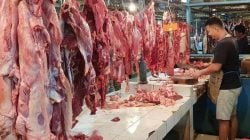Penulis: Ari Handoko (Mahasiswa Jurusan Ilmu Pangan Pascasarjana IPB University)
Reference:
Avellaneda, Z. E., Moure, M. P., Chotyakul, N., Torres, J. A., Chanes, J. W., & Lamela, C. P. 2011. Benefits and limitations of food processing by high-pressure technologies: effects on functional compounds and abiotic contaminants. Journal of Food, 9:4, 351-364.
Cap, M., Paredes, P. F., Fernandez, D., Mozgovoj, M., Vaudagna, S. R., & Rodriguez, A. 2019. Effect of high hydrostatic pressure on Salmonella spp. Inactivation and meat quality of frozen chicken breast. Food Science and Technology, 118: 1-5.
Kruk, Z. A., Yun, H., Rutley, D. L., Lee, E. J., Kim, Y. J., Jo, C. 2011. The effect of high pressure on microbial population, meat quality, and sensory characteristics of chicken breast fillet. Food Control, 22: 6-12.
Radovcic, N. M., Jezek, D., Markov, K., Frece, J., Curic, D., & Medic, H. 2019. The effect of high pressure treatment on the quality of chicken breast meat. Croation of Journal of Food Technology, Biotechnology, and Nutrition, 14(3-4): 76-81.
Torres, J. A., Sanz, P.D., Otero, L., Pe´rez, L. C., & Saldan˜a, M.D.A. 2009. Engineering principles to improve food quality and safety by high pressure processing. Processing effects on safety and quality of foods, 379–414. Boca Raton FL: CRC Taylor & Francis, Inc.








